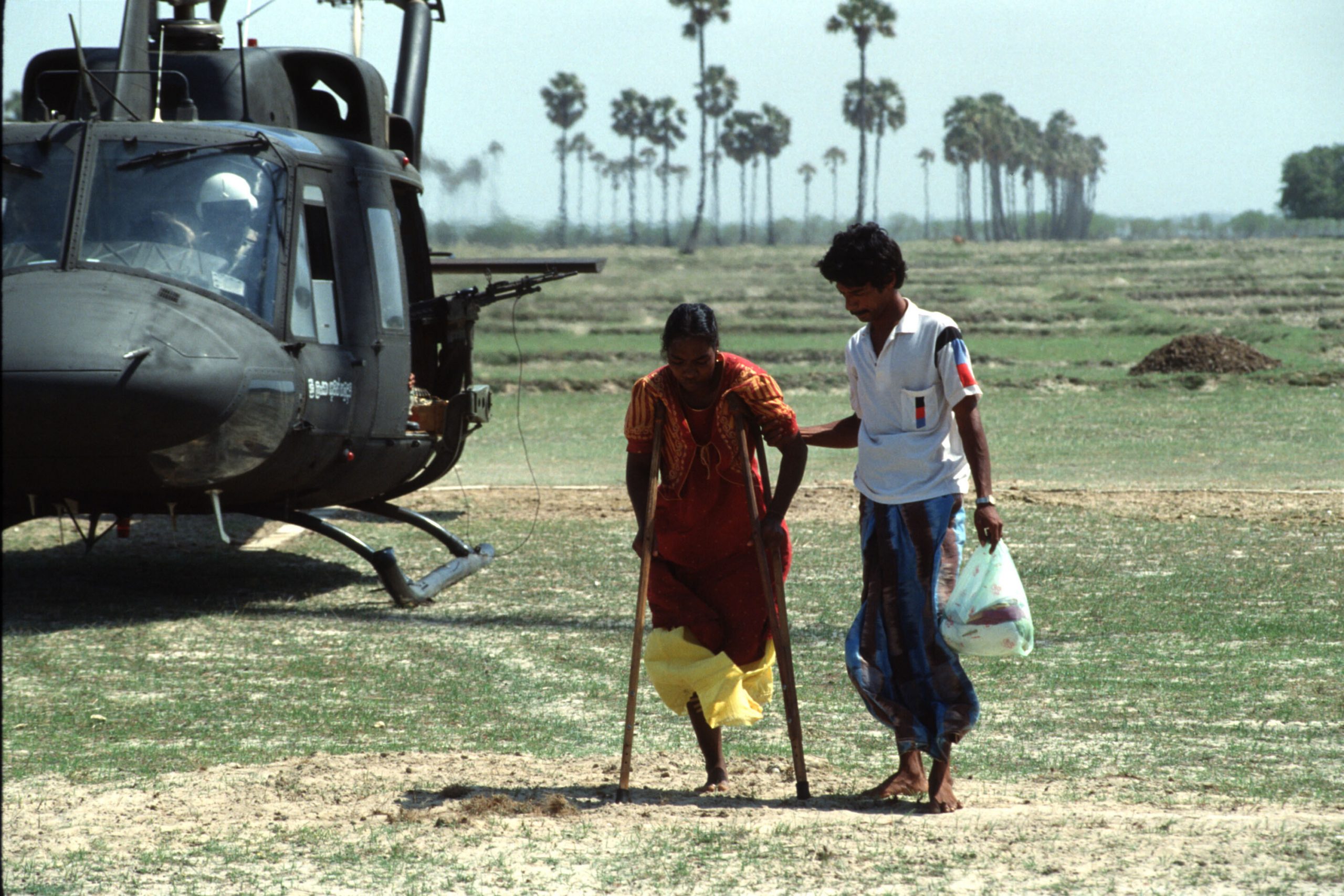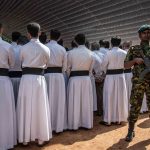Sri Lanka is still neglecting its displaced Muslims
In 1990, a separatist group fighting for a state for Hindu Tamils evicted thousands of Muslims from their homes. Some of the displaced yearn to return, but the Sri Lankan state won’t help.
Author:
17 December 2020

This October marked 30 years since tens of thousands of civilians, mostly Muslims, were evicted at gunpoint by the Liberation of Tamil Tigers Eelam (LTTE) from Sri Lanka’s northern Jaffna peninsula.
The movement of civilians was so “unprecedented and dramatic” that around 75 000 Muslims became internally displaced people in a short period of time. Between 15 and 30 October 1990, Muslims were evicted in their entirety from Northern Province areas such as Chavakachcheri, Mannar, Mullaitivu, Vavuniya and Kilinochchi.
As many as 3 500 Muslim families were forcefully evicted from the capital of Jaffna alone, leaving behind everything they owned. Members of the LTTE immediately snatched their belongings. University Teachers for Human Rights in Jaffna wrote in a 1991 report that the “collective loss of evictees was estimated to be $110 million”.
A delegation of Tamils and Catholic clerics tried to protest against the forcible eviction, but their efforts came to nought. The LTTE forbade all trade between Tamils and Muslims, and sealed off significant towns. The mass eviction would turn out to be inevitable, protest or no protest.
“LTTE was telling us that everything we owned and everything we possessed belonged to the northern homeland except ‘we people’, therefore Muslims needed to get out,” said 51-year-old women’s rights activist Shreen Saroor.
The majority of the evicted Muslim families had limited connections outside Jaffna. As such, a sizeable number of them, on reaching Puttalam, had to stay in schools and mosques with barely any food to eat and inadequate sanitation. Several survivors recalled how 40 families were sharing four toilets and two tube wells for several months after being displaced to different parts of northwest Sri Lanka.
Related article:
In the Mullaitivu region, at least 1 000 families were evicted. Their journey to other, friendlier places was fraught with hardships. Pregnant women reportedly delivered babies in the woods while travelling and it was difficult to get clean drinking water.
When parts of the Mannar Bridge – the only connection between Mannar Island and the mainland – collapsed after the LTTE blew it up, displaced northern Muslims had to take fishing boats to Kalpitiya in the neighbouring Puttalam district, said Saroor. There were many risks associated with these boats, particularly as they ferried 30 to 40 people at a time.
On reaching Puttalam near Sri Lanka’s west coast, up to 82% of these families chose to stay for an extended period of time. Their only support was a food parcel weighing 30kg and 630 Sri Lankan rupees provided by the World Food Programme. The scarcity of other necessities, besides food, was so prevalent that families sold a portion of their rice to get some cash.
Not every stratum of the Sri Lankan population ignored the plight of the evicted Muslims or chased them from the north. The majority-Muslim Poruthota community set up shelters for the forcibly evicted and provided food for them in Negombo. Residents of this region accommodated a huge number of displaced people in rental properties while their children were allowed to attend school without being asked for the usual paperwork.
What made the evictions possible?
It has been 30 years, but the suffering of more than 75 000 northern Sri Lankan Muslims continues to be overlooked. The state hasn’t acknowledged these wrongs, let alone initiated a programme of action towards reparations.
In the prelude of a 23-page report titled Stories of Roots and Return: 30 Years Since the Expulsion of the Northern Muslims, Saroor writes that the three decades of “neglect and misunderstanding by local residents, government officers, international donors and southern Muslims” have left northern Muslims feeling as though there is no one left for them to trust. “To date, this community’s sufferings have not been recognised officially, and there has been no adequate support for return or reparations.”
The evictions didn’t come as an isolated incident, writes Saroor, as there were a lot of incidents between Tamils and Muslims in the 1990s. “There was a lot of tension in the eastern provinces, especially after the massacre [at] Kattankudy mosque in August 1990,” she writes, when LTTE gunmen killed at least 300 Muslims inside mosques.
Related article:
The central assumption behind the forcible eviction is said to have been a growing suspicion among Tamils about the involvement of Muslims in intelligence operations. The LTTE suspected that security intelligence were using Muslim businesspeople who travelled frequently to Colombo as “agents or spies” to sabotage the insurgency through direct military intervention.
But researchers Dennis B McGilvray and Mirak Raheem offer two alternative explanations for the LTTE’s anti-Muslim violence in 1990. In a research report titled Muslim Perspectives on the Sri Lankan Conflict, they write that “it was collective punishment for and a precautionary measure against Muslim collusion with the state” and, secondly, “a natural consequence of the exclusivist politics of Tamil militancy and an expression of deep-seated Tamil ethnic chauvinism”.
Returning not without its problems
In 2009, as the fighting between Sinhalese nationalists and the LTTE came to an end, leaving trails of devastation and stories of killings and abuse, the Sri Lankan government called on displaced people to register if they wished to return to their ancestral lands. But observers said the state never provided the instructions or policy directions required to implement their return.
Some Muslims from Mannar district made an effort to return in 2010, for example, only to find that their houses had been destroyed. In other instances, entire homes had been swallowed up by thick forest. Activist Natasha Van-Hoff, who works with the People’s Alliance for Right to Land, said these lands are no longer the same.
“Firstly, because the jungles have taken over the land wherein Muslims dwelled in the north, as in the case of Musali. Secondly, due to military occupation that has affected both communities living in the north. For example, Mannar’s Silavathurai,” she said. The Sri Lanka navy occupied the area in 2007 and it is shared by an army camp as well.
The displaced Muslims also face property issues. “A number of people from other communities have started occupying their properties in Jaffna, assuming the northern Muslims won’t ever return, while in other cases several locals have illegally sold off northern Muslims’ property in Mullaitivu using forged documents and without the prior information of the actual owner,” said Van-Hoff.
ARM Imtiyaz and MCM Iqbal write in their study, The Displaced Northern Muslims of Sri Lanka: Special Problems and the Futures, that the Sri Lankan military has established camps to consolidate its victory and Sinhala settlers have moved in. “The Muslims in the Mullaitivu District who owned large stretches of agricultural land have these anxieties, and if the government continues to stick to this plan, they fear further marginalisation in the north.”
Related article:
Part of the 2002 ceasefire agreement between the rival parties to the conflict – the Sri Lankan government and the LTTE – provided for the return of displaced Muslims to northern districts. But many families attempted to return to Mullaitivu only to find that people from other communities had occupied their houses and land. The overall experience then dampened the zeal of these communities to return when the civil war finally came to an end in 2009, and northern Muslims remain distrustful of the Tamil populace in the area.
Distrust is, of course, not the only reason. Naturally, the end of the civil war brought new prospects for the possible resettlement of all displaced. However, northern Muslims were again sidelined. “The Sri Lanka government and international community prioritised the Tamil IDPs [internally displaced people] and resettled over 300 000 IDPs within six months,” wrote Mohammed Shareef, a research fellow at the University of Colombo.
Is there a way forward?
As a direct result of their displacement, a large number of northern Muslims are on the margins of politics, the economy and everything else. It follows, then, that they are least influential in the country’s polity, which has been dominated by loyalists of Sri Lanka’s Freedom Party and Sinhalese Buddhist monks.
While social alienation from the Tamils and violence by the majority Sinhalese has created friction and hostility, often fanned by propagandist elements within and outside the establishment, the process of rehabilitation and addressing the fault lines has seemingly become more complex. A portion of northern lands taken by the Sri Lankan military has further jeopardised the process of resettlement.
As a result of the prevailing official negligence towards northern Muslims in mainstream discussions, rights groups including the Sri Lanka Campaign and the Law and Society Trust have taken on the task of highlighting the plight of the displaced population.
Related article:
According to activist Amalini De Sayrah, associated with the Centre for Policy Alternatives, an advocacy group in Colombo, Sri Lanka, the presence of administrational bias and hesitancy to register displaced Muslims continues to pose a structural challenge for internally displaced people.
“Those families who have settled in Puttalam would never think of returning to the north unless adequate infrastructure is offered there,” said De Sayrah. “Why would anyone want to return to a state of displaced places.”
Former president Mahinda Rajapaksa promised in December 2009 to appoint a presidential commission to look into the mass eviction of northern Muslims. He also committed to resettle displaced Muslims by the end of May 2010. This never happened, and the situation has worsened for Muslims, especially after the Easter Sunday attacks in April 2019 in which at least 269 people died in coordinated bomb blasts in churches and hostels across Colombo.
Anti-Muslim sentiment among the majority Sinhalese community has grown multifold, leading to more attacks on mosques and Muslim-owned properties in northwestern provinces such as in Kiniyama and Puttalam. With the appointment of President Gotabaya Rajapaksa in November 2019, the ethnic divide between Tamils and Sinhalese communities in Sri Lanka appears to have widened.
Rajapaksa is the first military officer to become president in Sri Lanka. Formerly, he served as the defence secretary during his elder brother Mahinda Rajapaksa’s presidency, between 2005 and 2014. Several human rights organisations accuse him of carrying out widespread violations and coming down heavily on dissent by subjecting critics, activists and journalists to enforced disappearances. Rajapaksa has also been blamed for carrying out military operations that killed around 40 000 Tamils during the final stage of the war in the country.
“Seemingly, the Sri Lanka government doesn’t have a policy or plan with regard to resettlement. We have to go on our own,” said Saroor. “Nowhere in the Sri Lankan statistics [is] there recognition that the country has IDPs. If justice is to be served to us, we have to return to the north where we belong.”




